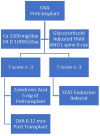Treatment of osteoporosis in the solid organ transplant recipient: an organ-based approach
- PMID: 40529292
- PMCID: PMC12171267
- DOI: 10.1177/20420188251347351
Treatment of osteoporosis in the solid organ transplant recipient: an organ-based approach
Abstract
Bone and mineral disorders are highly prevalent in solid organ transplant recipients. These patients are at high risk for osteoporosis and fragility fractures due to several pre- and post-transplant factors, including end-stage organ disease leading to chronic malnutrition and osteomalacia, as well as chronic immunosuppressive therapy that has direct adverse effects on bone remodeling. Low pre-transplant bone mineral density is associated with an increased risk for fragility fracture post-transplant. Furthermore, there is a precipitous loss of bone density within 6-12 months post-transplant due to a myriad of causal factors. In this review, we will elaborate on the treatment options and challenges in management of osteoporosis in solid organ recipients using vitamin D, calcium, bisphosphonates, denosumab, and osteoanabolic agents. The greatest body of evidence discusses the use of bisphosphonates, with most patients benefiting from early treatment.
Keywords: bisphosphonates; bone loss; fragility fracture; glucocorticoid; heart transplant; kidney transplant; liver transplant; lung transplant; osteoanabolic agents; osteoporosis; osteoporotic fracture; solid organ transplant.
Plain language summary
Review of treatment options for low bone density after solid organ transplant Increased survival in transplant recipients has resulted in the recognition of long-term complications in this population, including osteoporosis and fractures. Due to existing pre-transplant bone disease and post-transplant immunosuppressive therapies, solid organ transplant recipients are at an increased risk for bone loss and fracture. Pre-transplant risk factors should be optimized by addressing secondary etiologies of osteoporosis including vitamin D and calcium insufficiency. Unique bone health factors in kidney, liver, heart, and lung transplant recipients will be reviewed. Early treatment prevents the accelerated bone loss that happens in the immediate post-transplant period. Options for treatment that will be discussed include vitamin D, calcium, bisphosphonates, denosumab, and osteoanabolic agents.
© The Author(s), 2025.
Figures


Similar articles
-
Assessing the comparative effects of interventions in COPD: a tutorial on network meta-analysis for clinicians.Respir Res. 2024 Dec 21;25(1):438. doi: 10.1186/s12931-024-03056-x. Respir Res. 2024. PMID: 39709425 Free PMC article. Review.
-
Probability of achieving bone mineral density treatment goals with denosumab treatment in postmenopausal women with osteoporosis.J Bone Miner Res. 2025 Jun 3;40(6):766-772. doi: 10.1093/jbmr/zjaf014. J Bone Miner Res. 2025. PMID: 39861972 Free PMC article. Clinical Trial.
-
Bone density and fracture risk factors in ankylosing spondylitis: a meta-analysis.Osteoporos Int. 2024 Jan;35(1):25-40. doi: 10.1007/s00198-023-06925-1. Epub 2023 Oct 9. Osteoporos Int. 2024. PMID: 37814094
-
The Epidemiology and Pathogenesis of Osteoporosis.2020 Jun 21. In: Feingold KR, Ahmed SF, Anawalt B, Blackman MR, Boyce A, Chrousos G, Corpas E, de Herder WW, Dhatariya K, Dungan K, Hofland J, Kalra S, Kaltsas G, Kapoor N, Koch C, Kopp P, Korbonits M, Kovacs CS, Kuohung W, Laferrère B, Levy M, McGee EA, McLachlan R, Muzumdar R, Purnell J, Rey R, Sahay R, Shah AS, Singer F, Sperling MA, Stratakis CA, Trence DL, Wilson DP, editors. Endotext [Internet]. South Dartmouth (MA): MDText.com, Inc.; 2000–. 2020 Jun 21. In: Feingold KR, Ahmed SF, Anawalt B, Blackman MR, Boyce A, Chrousos G, Corpas E, de Herder WW, Dhatariya K, Dungan K, Hofland J, Kalra S, Kaltsas G, Kapoor N, Koch C, Kopp P, Korbonits M, Kovacs CS, Kuohung W, Laferrère B, Levy M, McGee EA, McLachlan R, Muzumdar R, Purnell J, Rey R, Sahay R, Shah AS, Singer F, Sperling MA, Stratakis CA, Trence DL, Wilson DP, editors. Endotext [Internet]. South Dartmouth (MA): MDText.com, Inc.; 2000–. PMID: 25905357 Free Books & Documents. Review.
-
Use of β-adrenoreceptor drugs and Parkinson's disease incidence in women from the French E3N cohort study.J Parkinsons Dis. 2025 Jun;15(4):789-804. doi: 10.1177/1877718X251330993. Epub 2025 Apr 29. J Parkinsons Dis. 2025. PMID: 40302366
Cited by
-
The missing piece in post-transplant bone health: tertiary hyperparathyroidism management.Ther Adv Endocrinol Metab. 2025 Jul 18;16:20420188251359790. doi: 10.1177/20420188251359790. eCollection 2025. Ther Adv Endocrinol Metab. 2025. PMID: 40689341 Free PMC article. No abstract available.
References
-
- Kasiske BL, Lentine KL, Ahn Y, et al. OPTN/SRTR 2020 annual data report: living donor collective. Am J Transplant 2022; 22: 553–586. - PubMed
-
- Ferreira LD, Goff C, Kamepalli S, et al. Survival benefit of solid-organ transplantation: 10-year update. Dig Dis Sci 2023; 68(9): 3810–3817. - PubMed
-
- Humphrey MB, Russell L, Danila MI, et al. 2022 American College of Rheumatology Guideline for the prevention and treatment of glucocorticoid-induced osteoporosis. Arthritis Rheumatol 2023; 75(12): 2088–2102. - PubMed
Publication types
LinkOut - more resources
Full Text Sources

